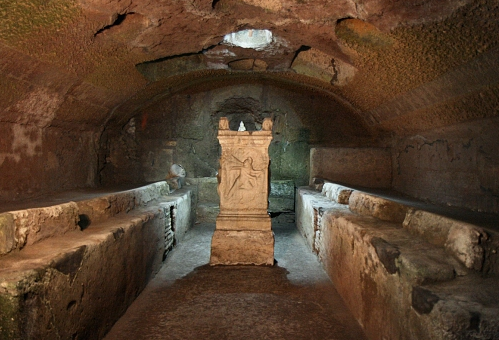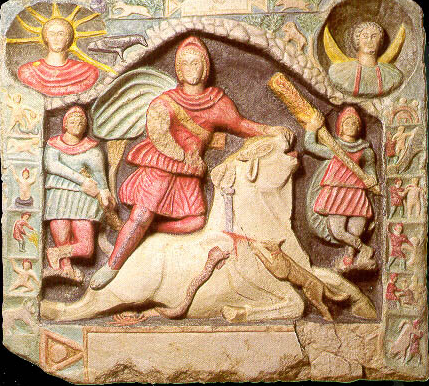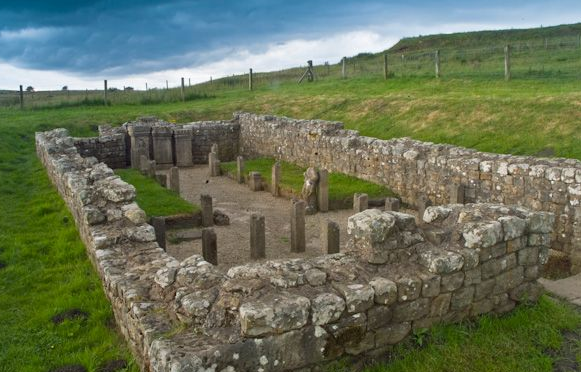
“Hear us great Father of Light! Receive our thanks for delivering us from the dark.”
(Gaius Justus Vitalis; IMMORTUI)

Mithras
In the ancient world most people believed in the gods, believed that the gods played a role in all aspects of life. Whether it was a major battle to decide who would rule the known world, or something as simple and mundane as keeping a person safe on a journey to the next town. People, one could say, held their gods close on a daily basis. Not just once a week or at the holidays.
For the men serving in Rome’s legions there was one god to which many turned when they faced death on an almost daily basis: Mithras.
For Gaius Justus Vitalis and the other soldiers who inhabit the world of The Carpathian Interlude, Mithras is the light with which to combat the dark on the edge of empire.
But who was this strange god who was relatively new to the Roman Pantheon?

Ahura Mazda – from the ruins of Persepolis
Mithras originated as an ancient Persian god of Truth and Light whose cult was an offshoot of Zoroastrianism, the ancient Persian religion, which recognized Ahura Mazda as sole creator of the universe. In mythology, Mithras supported Ahura Mazda in a struggle against the evil Ahriman. This struggle of Good/Light vs. Evil/Darkness is at the heart of Mithraism.
Mithras was sent by Ahura Mazda to hunt and kill the ‘divine bull’ and from the bull’s blood, all life sprang. This is the creation myth of Zoroastrianism and the ‘Tauroctony’, the slaying of the bull, is the central image, the greatest rite, of Mithraism.
When Mithras captured the bull, he is said to have taken it to a cave and there, slain it. That is why most Temples to Mithras (known as a Mithraeum) were in caves (speleum), or dark rooms made to look like caves. Over time, because of his identification with the Light, Mithras also became identified with the sun, and altars to Sol Invictus, the ‘unconquered sun’, were associated with his worship.
The cult of Mithras seems to have come to Rome in the second half of the first century B.C., likely encountered by Roman soldiers who had been campaigning in the East with Marcus Licinius Crassus and Mark Antony against the Parthians.

Mithraeum – San Clemente, Rome
Mithraism was one of the ancient ‘mystery religions’. These were religious cults in which initiates swore a solemn oath not to reveal the rites and activities involved. As a result, very little is actually known. Other mystery religions of the ancient world included the Elefsinian Mysteries (dedicated to Demeter and Persephone), the cult of Isis (the Egyptian goddess worshipped as mother/wife, patroness of nature and magic, and friend of slaves, sinners, artisans and the downtrodden), and the cult of Serapis (Hellenistic god intended to merge the Greek and Egyptian religions).
Mithraism was different from the other mystery religions in that it was for men only. During the Roman Empire its appeal had grown so much that Mithraea (dimly lit temple-caves or rooms) could be found outside of Roman forts across the whole of the empire. Why was this, a foreign religion, so intensely popular among the eagles of Rome?
Some believe that Mithraism may have appealed more because of its stronger promise of an afterlife and more personal relationship with the god. Understandable when one is facing death regularly. Also central to the religion were the attributes of Strength, Courage and Endurance which would have been highly valued by the soldier-adherents.

Mithras as Sol Invictus
In The Carpathian Interlude, Gaius Justus Vitalis is referred to as the Heliodromus or ‘Sun Runner’ which is his grade or rank in the cult. In Mithraism there were in fact seven grades of initiation each associated with a deity. These were (from lowest to highest): Corax (Mercury), Nymphus (Venus), Miles (Mars), Leo (Jupiter), Perses (Luna), Heliodromus (Sol), and Pater (Saturn).
Each of these grades was also associated with a particular symbol such as a torch for the Heliodromus, or a mitre for the Pater. Did the rites involve the use in some way of these symbols for each of the initiates? Perhaps. There is no way to know for certain. What is known is that these symbols appear on many of the elaborate carvings that have been found. They are full of symbolism, as is much of ancient and medieval art.
Mithraism was, however, not just a religion, it was a very close-knit society, a sort of club. Much as members of the Masonic Order, initiates of the Mithraic mysteries likely helped their brothers to advance, and provided aid in times of need. There would have been an understanding among them that they were not alone, that each was there for the other. It was a strong network across the empire.

Mithraic symbols and the Tauroctony
It has been hypothesized that Mithraism was the precursor of Christianity, not only because of its monotheistic nature and the battle between Light and Dark (which is universal) but also for the inclusion of such rites as baptism and a ritual meal. The date associated with the birth of Mithras is also December 25. It’s a very interesting idea and may, partially, explain the widespread integration of Christianity in the later empire.
In The Carpathian Interlude, Gaius Justus Vitalis and his men find rejuvenation in the Mithraic rites. They know that as they head into the darkness of the Carpathian mountains to face the terror of an unknown enemy, they will not be alone. The Light will guide them and, if they are to die, there is something bright, beyond the black river, that awaits them.

Mithraeum – Carrawburgh along Hadrian’s Wall
Stay tuned next week for Part II in this blog series on the world of The Carpathian Interlude.
Thank you for reading.



I once read in a novel (I won’t say which or by whom) of a woman initiate into the cult of Mithras. I commented that it was a male-only religion and received a response that there was evidence that some women were admitted. This was news to me. As a writer who is clearly well versed in the subject, I’m wondering what your thoughts are on this.
Hi Lin,
That’s interesting. Admittedly, in all my research, I have never come across any mention of woman initiates in the cult of Mithras. However, I don’t think it would be inconceivable for the wives or women of legionaries who were initiates to have some familiarity with the religion, to even perhaps offer thanks to Mithras who watched over their men in battle. Why not? I do explore this a bit in The Carpathian Interlude with Gaius’s wife, Fulvia. Now, this is for the Roman offshoot of Mithraism. As for the Zoroastrian religion which was more ancient and was what Mithraism sprang out of, there were female adherents. In fact today, there are female Zoroastrians. But, as far as Mithraism among the men of Rome’s legions, I don’t think there is any evidence of women taking part in the ceremonies or ceremonial meals in the sacred caves. As it is a mystery religion however, we may never know the truth of it. Hope this answers your question somewhat. Thanks so much for your comments! 🙂
Many thanks for your comments, Adam. I, too, had always believed it to be a male-only form of worship but, as you say, women may have offered some form of support. Thank you for all your articles, which I thoroughly enjoy.
Cheers, Lin 🙂 You’ve very welcome!
There is so much symbolism in the reliefs from the two torchbearers holding their torches in opposite directions with one facing up and the other down, to the snake, dog, etc, possibly symbolizing our night sky . One good location to find the symbolisms and more information about this cult is whitedragon.org.uk/articles/mithras.htm
Thank you again, Adam, for an interesting article.
Bonnie Miller
Thanks so much for your comment Bonnie 🙂 Yes, there is so much symbolism in the Tauroctony scene, some being more detailed than others. I’ll check out the website you shared – sounds interesting! Glad you enjoyed the piece on Mithras. More to come in this series! 🙂